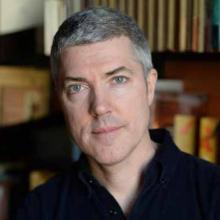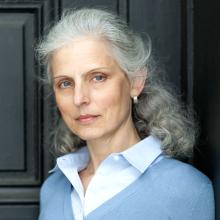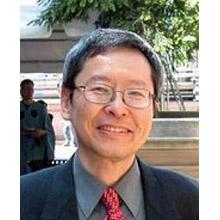 Matthew McKelway
Matthew McKelwayDIRECTOR of the MARY GRIGGS BURKE CENTER FOR JAPANESE ART TAKEO AND ITSUKO ATSUMI PROFESSOR OF JAPANESE ART HISTORY
Matthew McKelway specializes in the history of Japanese painting. His studies initially focused on urban representation in screen paintings of Kyoto (rakuchū rakugai zu) and the development of genre painting in early modern Japan, but have extended to Kano school painting, Rimpa, and individualist painters in eighteenth-century Kyoto. Some of these interests have converged in his essays on fan paintings, a subject of ongoing research. In his publications he has sought to understand Japanese paintings according to the physical and cultural contexts of their creators in order to discover the motivations, whether political, personal, literary, or philosophical, that drove them to make pictures in particular ways. He has been a visiting professor at the Free University of Berlin, University of Heidelberg, Seijō University, and Université Paris 1 Panthéon-Sorbonne. In 2017 he was awarded the Lenfest Distinguished Faculty Award.
- Jin Xu
Jane and Leopold Swergold Associate Professor of Chinese Art History
Jin Xu specializes in pre-modern Chinese art history, with a particular interest in art and architecture during the imperial period (221 BCE–1911 CE). His research focuses on the artistic expressions of migrants and their communities, including both non-Chinese immigrants in China and Chinese emigrants in border regions. He seeks to understand how the experience of migration shaped perceptions of art and how art, in turn, helped individuals make sense of their migratory lives and heritage. In his research, he also emphasizes the significance of material properties and technical processes in influencing the ways of seeing. His teaching covers a wide range of topics, including inter-regional artistic exchanges within East Asia, religious and funerary art, the art of the Silk Road, artistic materials and techniques, objects study, images and texts, rubbings and prints, and architecture and gardens.
 Anne Higonnet
Anne HigonnetProfessor Barnard College Columbia University
Anne Higonnet is Professor of Art History at Barnard College, Columbia University. She received her BA from Harvard College in 1980 and her PhD from Yale University in 1988. Her work has been supported by Getty, Guggenheim, and Social Science Research Council fellowships, as well as by grants from the Mellon, Howard and Kress Foundations. In 2019-2020 she was a Fellow at the Harvard-Radcliffe Institute. She has published many essays, five print books, and two book-scale digital projects. She is a prize-winning teacher, and has lectured widely, including in the Live Arts program of the Met Museum.
- Subhashini Kaligotla
Barbara Stoler Miller Associate Professor of Indian and South Asian Art
Subhashini Kaligotla is a poet and art historian of premodern South Asia, with special interests in sacred architecture, the agency of makers, materials, and spaces, text-image relations, and historiography. Her first book, Shiva’s Waterfront Temples: Architects and their Audiences in Medieval India (Yale, 2022), centered the ingenuity of Deccan Indian creators. Her current book project, Seeing Ghosts, is an exploration of South Asian reckonings with transience. Encompassing religious and worldly views, the transcultural study charts the life story of the dead, from the moment of death to their memorialization and afterlife, through the interpretive spine of art historical media.
 D. Max Moerman
D. Max MoermanPROFESSOR BARNARD COLLEGE COLUMBIA UNIVERSITY
Max Moerman (Ph. D. Stanford University, 1999) is Professor in the Department of Asian and Middle Eastern Cultures, Barnard College, Columbia University and Co-Chair of the Columbia University Seminar on Buddhist Studies. His research interests lie in the visual and material culture of pre-modern Japanese Buddhism. His publications have examined such topics as the representation of pilgrimage landscapes in painting, literature, and ritual; the burial of sutras and Buddhist images at sites in Northern Kyushu and at the Ise shrines; the death of the Buddha in medieval painting and Edo-period print culture; islands of women in the history of Japanese cartography; narrative and iconographic traditions of lepers and hot springs; woodblock printed talismans used in feudal oaths, economic contracts, and legal disputes; and the history of the Japanese Buddhist world map.
 Haruo Shirane
Haruo ShiraneSHINCHO PROFESSOR OF JAPANESE LITERATURE Chairman of EALAC
Professor Haruo Shirane teaches Japanese literature and cultural history, with particular focus on prose fiction, poetry, performative genres (such as storytelling and theater), and visual culture. Shirane is currently interested in the relationship of classical and medieval cultures to early modern and contemporary cultures, looking at issues of gender, manuscript culture, print capitalism, performance and media. His most recent book, Japan and the Culture of the Four Seasons, explored the cultural construction of nature and the environment across a wide spectrum of literature, media, and visual arts from the ancient period to the modern. Shirane is finishing a book called Media, Performance, and Popular Culture: De-Centering Japanese Literature, which recontextualizes Japanese literature in a broader comparative context, focusing on the role of material culture, media, orality, and performance. Read Prof. Shirane's full biography on EALAC
 Takuya Tsunoda
Takuya TsunodaAssistant Professor of Japanese Film and Media EALAC
Takuya Tsunoda (Ph.D. Yale) is Assistant Professor of Japanese film and media in the Department of East Asian Languages and Cultures at Columbia University. His research centers on the interplay between institutions and media, technologies and sociocultural practices, science and material culture, and representation and knowledge formations. His current book project highlights the historical and theoretical intersection between media-based governmental and civic activities, cross-medial articulation of academicism in Japan, science and public relations (PR) films, and a postwar struggle over the legacy and meaning of cinematic modernism. His works have appeared in A Companion to Japanese Cinema and the Journal of Japanese and Korean Cinema among others.
